|
|
|
Sort Order |
|
|
|
Items / Page
|
|
|
|
|
|
|
| Srl | Item |
| 1 |
ID:
121291
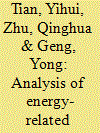

|
|
|
|
|
| Publication |
2013.
|
| Summary/Abstract |
With China's increasing pressures on reducing greenhouse gas (GHG) emission, Chinese iron and steel industry (ISI) is facing a great challenge. In this paper, we address the energy-related GHG emission trajectories, features, and driving forces in Chinese ISI for 2001-2010. First, energy related GHG inventory for ISI is made for both scope 1 (direct emissions) and scope 2 (including imported electricity emission). Then, the driving forces for such emission changes are explored by utilizing the method of logarithmic mean Divisa index (LMDI) decomposition analysis. Results indicate that Chinese ISI experienced a rapid growth of energy related GHG emission at average annual growth rate of 70 million tons CO2e. Production scale effect is the main driving factor for energy related GHG emission increase in Chinese ISI, while energy intensity effect and emission factor change effect offset the total increase and energy structure has marginal effect. Construction, manufacture of general purpose and special purpose machinery and manufacture of transport equipment sectors are main sectors for embodied emissions, amounting for more than 75% of the total embodied emissions from Chinese ISI. Such research findings propose that a detailed consideration can help make appropriate polices for mitigating ISI's energy-related GHG emission.
|
|
|
|
|
|
|
|
|
|
|
|
|
|
|
|
| 2 |
ID:
150669
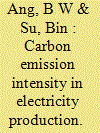

|
|
|
|
|
| Summary/Abstract |
We study changes in the aggregate carbon intensity (ACI) for electricity at the global and country levels. The ACI is defined as the energy-related CO2 emissions in electricity production divided by the electricity produced. It is a performance indicator since a decrease in its value is a desirable outcome from the environmental and climate change viewpoints. From 1990 to 2013, the ACI computed at the global level decreased only marginally. However, fairly substantial decreases were observed in many countries. This apparent anomaly arises from a geographical shift in global electricity production with countries having a high ACI increasingly taking up a larger electricity production share. It is found that globally and in most major electricity producing countries, reduction in their ACI was due mainly to improvements in the thermal efficiency of electricity generation rather than to fuel switching. Estimates of the above-mentioned effects are made using LMDI decomposition analysis. Our study reveals several challenges in reducing global CO2 emissions from the electricity production sector although technically the reduction potential for the sector is known to be great.
|
|
|
|
|
|
|
|
|
|
|
|
|
|
|
|
| 3 |
ID:
171514
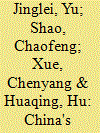

|
|
|
|
|
| Summary/Abstract |
In order to explore the decoupling relationship and its influence factors between the growth of China's civil aviation sector and carbon emissions, as well as to forecast future CO2 emissions, the extended log-mean Divisia index model (LMDI), Tapio decoupling model and an emission prediction model were applied in this study. The results show the following. (1) Total carbon emissions fluctuate on an overall upward trend, but the level of oil consumption per revenue tonne-kilometers (RTK) shows a steady downward trend. (2) Among the four main factors, the “transportation amount growth” factor contributed most to CO2 emissions increases; followed by transport structure adjustment effects and alternative fuel effects. The “energy consumption intensity” factor plays a major role in inhibiting CO2 emissions. (3) The decoupling state of civil aviation predominantly stayed in a weak decoupling prior to 1988, expansive coupling and expansive negative decoupling during 1988–2000, and expansive coupling post-2000, which implies that the government should take comprehensive measures to reduce CO2 emissions. (4) Based on eight scenarios, China's civil aviation sector is predicted to be responsible for 0.13 Gt of CO2 emissions by 2020. Between 2020 and 2050, CO2 emissions may increase by a factor 1.6 to 3.9.
|
|
|
|
|
|
|
|
|
|
|
|
|
|
|
|
| 4 |
ID:
117233
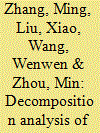

|
|
|
|
|
| Publication |
2013.
|
| Summary/Abstract |
Electricity generation in China mainly depends on coal and its products, which has led to the increase in CO2 emissions. This paper intends to analyze the current status of CO2 emissions from electricity generation in China during the period 1991-2009, and apply the logarithmic mean Divisia index (LMDI) technique to find the nature of the factors influencing the changes in CO2 emissions. The main results as follows: (1) CO2 emission from electricity generation has increased from 530.96 Mt in 1991 to 2393.02 Mt in 2009, following an annual growth rate of 8.72%. Coal products is the main fuel type for thermal power generation, which accounts for more than 90% CO2 emissions from electricity generation. (2) This paper also presents CO2 emissions factor of electricity consumption, which help calculate CO2 emission from final electricity consumption. (3) In China, the economic activity effect is the most important contributor to increase CO2 emissions from electricity generation, but the electricity generation efficiency effect plays the dominant role in decreasing CO2 emissions.
|
|
|
|
|
|
|
|
|
|
|
|
|
|
|
|
| 5 |
ID:
125837


|
|
|
|
|
| Publication |
2013.
|
| Summary/Abstract |
In this article, we decomposed Korean industrial manufacturing greenhouse gas (GHG) emissions using the log mean Divisia index (LMDI) method, both multiplicatively and additively. Changes in industrial CO2 emissions from 1991 to 2009 may be studied by quantifying the contributions from changes in five different factors: overall industrial activity (activity effect), industrial activity mix (structure effect), sectoral energy intensity (intensity effect), sectoral energy mix (energy-mix effect) and CO2 emission factors (emission-factor effect). The results indicate that the structure effect and intensity effect played roles in reducing GHG emissions, and the structure effect played a bigger role than the intensity effect. The energy-mix effect increased GHG emissions, and the emission-factor effect decreased GHG emissions. The time series analysis indicates that the GHG emission pattern was changed before and after the International Monetary Fund (IMF) regime in Korea. The structure effect and the intensity effect had contributed more in emission reductions after rather than before the IMF regime in Korea. The structure effect and intensity effect have been stimulated since the high oil price period after 2001.
|
|
|
|
|
|
|
|
|
|
|
|
|
|
|
|
| 6 |
ID:
133301


|
|
|
|
|
| Publication |
2014.
|
| Summary/Abstract |
This paper aims at analysing the factors behind the change in aggregate energy consumption in the EU-27, also identifying differences between member states. The logarithmic-mean Divisia index method (LMDI) is applied to multiplicatively decompose, at the country level, the variation in aggregate energy consumption in the EU-27 member states for the 2001-2008 period. We also analyse the sensitivity of the results when several aggregation levels are considered, with energy intensity used as the criterion to aggregate countries. This allows us to check robustness of results, also enabling an improved understanding of both inter and intra-unit effects. Results indicate that improvements in energy efficiency in the EU-27 were not enough to overcome the pressure of European economic activity on aggregate energy consumption. Mediterranean countries, and especially former communist states, increased their energy consumptions, most of them favoured by structural change. The analysis also reveals that the impact of intra-group movements on aggregate energy consumption is partially offset when moving from higher to lower aggregation levels.
|
|
|
|
|
|
|
|
|
|
|
|
|
|
|
|
| 7 |
ID:
166530


|
|
|
|
|
| Summary/Abstract |
Index Decomposition Analysis (IDA) has been used to analyze driving forces of aggregate carbon intensity (ACI). However, previous studies mostly explained changes in ACI from either sectoral or regional perspective, but rarely looked into driving forces of ACI from both sectoral and regional perspectives under a unified and consistent framework. To fill the research gap, this study proposed a multi-region multi-sector decomposition and attribution approach to analyze driving forces of ACI from both sectoral and regional perspectives. The empirical results in China show that the ACI declined by 33% from 2000 to 2015. From the sectoral perspective, the decline can be mainly attributed to the significant energy efficiency improvement in six high energy-intensive industries. However, the rapid growth in electricity consumption, especially in chemicals and iron and steel, and the expansion of iron and steel industry during 2000–2005 greatly offset the negative effect from energy efficiency. From the regional perspective, the ACI decline can be primarily due to an extensive improvement in energy efficiency in most regions. On the contrary, the increasing dependency on coal, particularly in Shandong, Inner Mongolia, and Guangdong, and the increased share of carbon-intensive industries in some provinces such as Guangxi and Sichuan, markedly increased ACI. Based on the results, the effectiveness of underlying sectoral and regional level policies and measures implemented for ACI reduction in China were evaluated.
|
|
|
|
|
|
|
|
|
|
|
|
|
|
|
|
| 8 |
ID:
092775
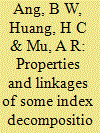

|
|
|
|
|
| Publication |
2009.
|
| Summary/Abstract |
We study the properties and linkages of some popular index decomposition analysis (IDA) methods in energy and carbon emission analyses. Specifically, we introduce a simple relationship between the arithmetic mean Divisia index (AMDI) method and the logarithmic mean Divisia index method I (LMDI I), and show that such a relationship can be extended to cover most IDA methods linked to the Divisia index. We also formalize the relationship between the Laspeyres index method and the Shapley value in the IDA context. Similarly, such a relationship can be extended to cover other IDA methods linked to the Laspeyres index through defining the characteristic function in the Shapley value. It is found that these properties and linkages apply to decomposition of changes conducted additively. Similar properties and linkages cannot be established in the multiplicative case. The implications of the findings on IDA studies are discussed.
|
|
|
|
|
|
|
|
|
|
|
|
|
|
|
|
| 9 |
ID:
161823


|
|
|
|
|
| Summary/Abstract |
This study first traces value added in gross exports of China during 2000–2014 to four components, namely domestic value added absorbed abroad (DVA), domestic value added return home (RDV), foreign value added (FVA), and pure double-counted terms (PDC), then compares these four components in China's exports with those in exports of the USA, Japan, Korea, and India. Second, this paper proposes a generalized logarithmic mean Divisia index (GLMDI) method and combines additive and multiplicative decomposition to decompose DVA gaps between China and the other four countries into value added coefficient effect, input-output structure effect, domestic scale effect and foreign scale effect. The aggregate value added coefficient effect is then attributed to sectoral level. Results show that DVA always occupied the largest share in the gross exports of China, which ranged from 74.60–82.84% during 2000–2014. Before 2011, DVA share of China's exports was generally the second smallest among five countries; since 2011, DVA share of China's exports increased, and China had the largest DVA share in 2014 (81.39%). Sectors having a large FVA share in China's exports usually had a large DVA share, such as “Mining” (MIN), “Computers, Electronic and Optical” (CEO), and “Basic Metals” (BAS). Additive and multiplicative decomposition analyses indicate that value added coefficients had a negative and increased effect on DVA gaps between China and the other four countries. Attribution analysis revealed that CEO sector had the largest negative value added coefficient effect in comparison between China and the USA, Japan, and Korea and its effect increased in comparison between China and the other four countries. Policy implications derived are finally discussed.
|
|
|
|
|
|
|
|
|
|
|
|
|
|
|
|
|
|
|
|
|